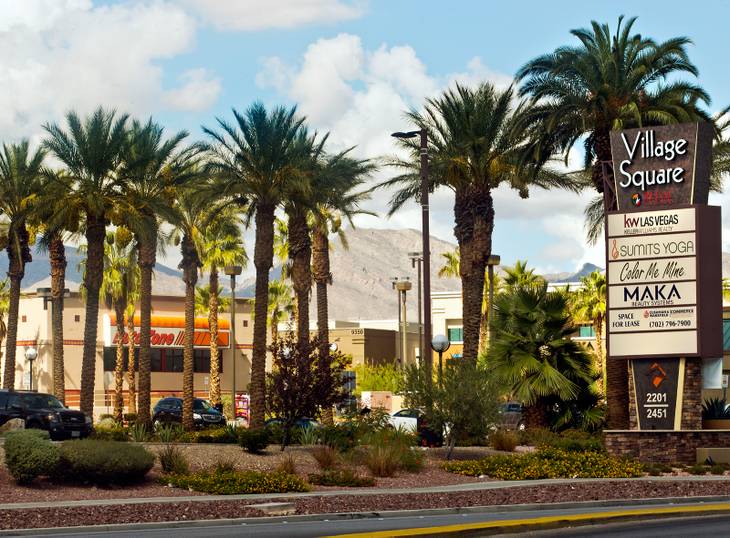A few years ago, after the recession pummeled Las Vegas, bargain-hunting investors gobbled up cheap commercial properties throughout the valley, sometimes buying in bulk.
Today, the economy is on the mend, real estate values are climbing, profits are getting pinched — and buyers are taking their money elsewhere.
Sales of Southern Nevada office buildings, shopping plazas, warehouses and apartment complexes have dropped in 2015 to the slowest pace in years. At the same time, prices have soared.
“The fire sales that once existed are much tougher to find,” said Brian Gordon, a principal with research and consulting firm Applied Analysis.
Investment sales are by no means grinding to a halt, but brokers, investors and other market watchers say buyers have pulled back for a number of reasons. Landlords don’t feel as pressured to cut their losses and unload properties as they did three or four years ago, when the economy was in shambles; sellers are commanding higher prices — or at least trying to — amid higher occupancy and rental rates; and there are a lot fewer bank-owned, underwater or other distressed properties, which typically sell at steep discounts, on the market.
Buyers continue hunting for deals, but “there’s just not a lot of them out there now,” said broker Cathy Jones, owner of Sun Commercial Real Estate.
According to brokerage firm Colliers International:
• Investors bought 23 office buildings this year through June, a pace of 46 for the year, and paid an average of $181.65 per square foot. That compares with 87 sales at an average of $89.11 per square foot in all of 2012.
• Buyers this year also picked up 17 industrial buildings through June and paid an average of $88.53 per square foot. In 2012, investors bought 77 industrial properties for an average of $61.11 per square foot.
• Retail-center sales and prices are down from last year, but the pace of purchases is the slowest since 2012 and, except last year, prices are the highest since at least 2011. Investors bought 17 plazas through June, for an average price of $158.36 per square foot. By comparison, in 2013, buyers picked up 48 shopping centers, for an average price of $97.21 per square foot.
• The biggest drop in sales, however, has been with apartments. Landlords bought 2,779 units this year through June for an average of $84,742 per unit. In 2012, investors snapped up 21,840 units, at an average price of $65,425 per unit.
The apartment business — helped in no small part by the valley’s housing crisis, which wrecked many residents’ finances and ability to buy a place — has been one of the most-robust aspects of Las Vegas’ commercial property industry the past few years, with widespread construction, more tenants and higher rents. Many landlords believe the market will further strengthen and are waiting for big offers from buyers.
“They are going to hang on and get a little more of what they believe they deserve,” Colliers broker Garry Cuff said.
John Stater, Las Vegas research manager for Colliers, said the broader market’s slowdown isn’t necessarily a bad thing and reflects a diminished inventory of low-priced properties. He noted that investors “found a lot of good deals” in the valley after the economy tanked, and when prices rise, sales volume tends to drop.
“We’re out of that desperation phase,” Stater said.
Investor Tyler Mattox, a co-owner of MCA Realty in Irvine, Calif., knows this firsthand. His group owns 14 industrial properties in the valley, totaling more than 600,000 square feet. After he and his partners launched MCA in 2011, their sales pitch to investors was basically, “How much worse could it really get?”
Their first building here was just 30 percent occupied, and rental rates at some early acquisitions had plunged under previous owners. Landlords did whatever was needed to keep tenants from fleeing, “to the point of absurdity in some cases,” Mattox said, including chopping rental prices.
MCA paid about $25 per square foot in its first few purchases here. Fast forward a few years, and Mattox paid between $55 and $85 per square foot on four recent deals in the valley.
He attributed the valley's investment slowdown in large part to the dearth of financially struggling buildings available for sale. But he said good deals are still out there, and his group isn’t finished buying in Southern Nevada.
MCA also owns buildings in Southern and Northern California, Phoenix, and Austin, Texas. According to Mattox, Las Vegas “still has a longer ways to go ... than virtually anywhere else” before returning to peak prices.
“We still feel there’s pretty good opportunity in Vegas, even though values have come up a lot,” he said.
After the market collapsed, investors bought, among other things, bulk quantities of office buildings, shopping centers and fast-food restaurant properties in the valley. Such buyers figured the battered market would recover and that their discounted yet risky purchases would eventually make them big profits.
The market was weak and unstable, and according to CBRE Group broker Marlene Fujita, many landlords “were just cutting their losses” and selling. Today, with historically low interest rates and increased bank lending, landlords can refinance their debt and hold properties for another five to 10 years.
“The urgency to sell isn’t there,” Fujita said.
One factor that could be scaring some buyers away is that, as researcher Gordon noted, sales prices are rising faster than rental rates, potentially crimping profits for new investors. But many landlords have cashed in or now are trying to.
Houston developer Hines Interests and Los Angeles investment firm Oaktree Capital Management bought 32 office buildings in Summerlin in fall 2012 for $119.5 million. At the time, only about half of the 1.1 million-square-foot portfolio was occupied.
They sold more than a dozen buildings in 2013 and 2014 to ultra-low-cost airline Allegiant Travel Co., and they now want to unload the rest. Las Vegas brokers with CBRE last week listed for sale the remaining 18 buildings, totaling more than 895,000 square feet.
The listing does not have an asking price, but the properties are a combined 92 percent occupied, CBRE broker Charles Moore said.
One group that recently booked a big profit on a market-bottom purchase was Westport Capital Partners. The company bought Village Square, a 250,000-square-foot shopping center at Sahara Avenue and Fort Apache Road, out of foreclosure in 2011 for $17.5 million, Clark County records show.
It sold the property to New York’s DRA Advisors for about $37.8 million. The sale was recorded Oct. 2.
Westport executives did not return a call for comment, and DRA acquisitions director Scott Lebenhart said his group is “unable to comment on any of our transactions.”
Anchored by a Regal Cinemas multiplex, Village Square was once a thriving shopping center that all but collapsed with the recession. In 2007, it was 94.5 percent leased, but by 2009, occupancy had plunged to 51 percent in its retail space and to 63 percent in its office component, according to reports.
“Once the recession hit, it just tanked, and it was a ghetto,” said longtime Las Vegas resident Sherman Ray.
Ray and his wife, Linda, opened Avery’s Coffee in Village Square in fall 2013. He said their storefront had been empty for three years before they moved in.
Westport spruced up Village Square with new signage, paint, lighting and landscaping. But the plaza’s upgrades “really didn’t matter,” Sherman Ray said, because residents “were so used to this place being so run down that nobody was looking to even come here.”
There were just a few other tenants in his corner of the shopping center when Avery’s opened, and within a month, stores had closed. The Rays had signed a three-year lease and worried they might have to shut down.
“There was no foot traffic at all,” Sherman Ray said. “There was absolutely nothing over here.”
Today, the plaza has a lot more tenants, and at times, Ray said, parking is tight.
“The center definitely is a lot more lively,” he said.
Eli Segall can be reached at 702-259-2309 or [email protected]. Follow Eli on Twitter at twitter.com/eli_segall.

